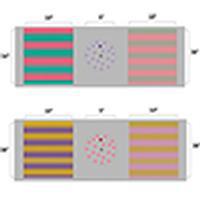当前位置:
X-MOL 学术
›
J. Opt. Soc. Am. A
›
论文详情
Our official English website, www.x-mol.net, welcomes your feedback! (Note: you will need to create a separate account there.)
Chromatic discriminations along two cardinal axes share a common attentional resource.
Journal of the Optical Society of America A ( IF 1.9 ) Pub Date : 2020-04-01 , DOI: 10.1364/josaa.382161 Xiaohua Zhuang , Dingcai Cao
Journal of the Optical Society of America A ( IF 1.9 ) Pub Date : 2020-04-01 , DOI: 10.1364/josaa.382161 Xiaohua Zhuang , Dingcai Cao

|
Attentional modulation is specific to either luminance or chromatic contrast discrimination, implying separate attentional resources for processing luminance and chromatic information processing [e.g., Curr. Biol.12, 1134 (2002)CUBLE20960-982210.1016/S0960-9822(02)00921-1]. However, there are two distinct visual pathways that process chromatic information: the parvocellular (PC) and koniocellular (KC) pathways. It is unclear whether there are separate attentional resources modulating the chromatic processes in these pathways. Here, we examined the attentional modulation effects on chromatic contrast discrimination with chromaticities along the $l$l or $s$s cardinal axis on a cone chromaticity space for preferentially stimulating either the inferred PC or KC pathway, respectively. A dual-task interference paradigm was used, and chromatic contrast discrimination sensitivities under dual-task conditions were compared with that under a single-task condition. The results revealed that compared with the single-task condition, attending to a competing central task in the dual-task condition decreased the peripheral discrimination sensitivity in both chromatic cardinal axes, and sensitivity reduced regardless of whether the dual tasks were along the same or different chromatic cardinal axes. These findings indicate that attentional effects on chromatic processes are not specific to the cardinal axis, suggesting that the PC and KC pathways may share a common attention resource in modulating chromatic processing.
中文翻译:

沿两个基本轴的色差共享一个共同的注意力资源。
注意调制特定于亮度或色差对比度判别,这意味着用于处理亮度和色度信息处理的单独注意资源[例如,Curr。[Biol.12,1134(2002)CUBLE20960-982210.1016 / S0960-9822(02)00921-1]。但是,有两种不同的视觉途径可以处理色度信息:细小细胞(PC)和单核细胞(KC)途径。尚不清楚是否有单独的注意力资源来调节这些途径中的色度过程。在这里,我们检查了锥度色度空间上沿$ l $ l或$ s $ s主色轴的色度对色度对比度判别的注意调制效果,分别分别刺激了推断的PC或KC途径。使用了双重任务干扰范例,将双任务条件下的色差和色差判别灵敏度与单任务条件下的色差进行对比。结果表明,与单任务条件相比,在双任务条件下参加竞争的中心任务会降低两个有色主轴的外周判别灵敏度,并且无论双任务沿着相同还是不同,灵敏度都会降低。彩色基本轴。这些发现表明,对色过程的注意力影响并非特定于基轴,这表明PC和KC途径可能在调制色过程中共享共同的注意力资源。结果表明,与单任务条件相比,在双任务条件下参加竞争的中心任务会降低两个有色主轴的外周判别灵敏度,并且无论双任务沿着相同还是不同,灵敏度都会降低。彩色基本轴。这些发现表明,对色过程的注意力影响并非特定于基轴,这表明PC和KC途径可能在调制色过程中共享共同的注意力资源。结果表明,与单任务条件相比,在双任务条件下参加竞争的中心任务会降低两个有色主轴的外周判别灵敏度,并且无论双任务沿着相同还是不同,灵敏度都会降低。彩色基本轴。这些发现表明,对色度过程的注意力影响并非特定于基轴,这表明PC和KC途径在调节色度过程中可能共享共同的注意力资源。
更新日期:2020-02-17
中文翻译:

沿两个基本轴的色差共享一个共同的注意力资源。
注意调制特定于亮度或色差对比度判别,这意味着用于处理亮度和色度信息处理的单独注意资源[例如,Curr。[Biol.12,1134(2002)CUBLE20960-982210.1016 / S0960-9822(02)00921-1]。但是,有两种不同的视觉途径可以处理色度信息:细小细胞(PC)和单核细胞(KC)途径。尚不清楚是否有单独的注意力资源来调节这些途径中的色度过程。在这里,我们检查了锥度色度空间上沿$ l $ l或$ s $ s主色轴的色度对色度对比度判别的注意调制效果,分别分别刺激了推断的PC或KC途径。使用了双重任务干扰范例,将双任务条件下的色差和色差判别灵敏度与单任务条件下的色差进行对比。结果表明,与单任务条件相比,在双任务条件下参加竞争的中心任务会降低两个有色主轴的外周判别灵敏度,并且无论双任务沿着相同还是不同,灵敏度都会降低。彩色基本轴。这些发现表明,对色过程的注意力影响并非特定于基轴,这表明PC和KC途径可能在调制色过程中共享共同的注意力资源。结果表明,与单任务条件相比,在双任务条件下参加竞争的中心任务会降低两个有色主轴的外周判别灵敏度,并且无论双任务沿着相同还是不同,灵敏度都会降低。彩色基本轴。这些发现表明,对色过程的注意力影响并非特定于基轴,这表明PC和KC途径可能在调制色过程中共享共同的注意力资源。结果表明,与单任务条件相比,在双任务条件下参加竞争的中心任务会降低两个有色主轴的外周判别灵敏度,并且无论双任务沿着相同还是不同,灵敏度都会降低。彩色基本轴。这些发现表明,对色度过程的注意力影响并非特定于基轴,这表明PC和KC途径在调节色度过程中可能共享共同的注意力资源。



























 京公网安备 11010802027423号
京公网安备 11010802027423号